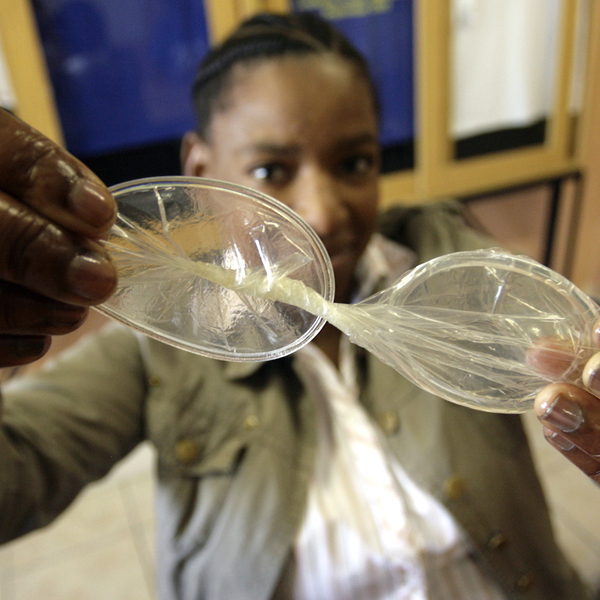The government is making female condoms more accessible – and these come with extra benefits.
Lineo Danke* closes her eyes to better concentrate on inserting the female condom, much as she would a tampon. The condom is 17cm long and made out of see-through rubber. It’s thin and soft and has two rings — one at the top of the condom and one at the bottom. The bedroom light shines unfamiliarly bright. Danke and her partner aren’t used to having sex with the light on. “We were clumsy and really anxious,” she explains. “It was like having sex for the first time but the light helped us with navigation and penetration.”
One ring of the condom is inserted into the vagina. It is smaller and more flexible than the other ring, which covers the outside of the vagina and holds the condom in place. The condom is prelubricated to make it easier to insert.
Danke (25) and Ayanda Hadebe* (33) are using the Lovers Plus Inner Condom, also known as the FC2.
“We second guessed ourselves all the time. We kept on asking each other if we were doing it right,” Danke says.
In an effort to find alternative methods to prevent pregnancy and HIV infection, the couple decided to try out three different female condoms — the Lovers Plus Inner Condom, the Cupid and the V, which is also known as the Woman’s Condom (see “The female condom showdown: Lovers Plus Inner Condom, the Cupid and the V”). Each of these condoms need to be inserted inside the vagina before sex.
“I have been curious as to how female condoms work, but not curious enough to try them out until now,” Danke says. “In most places, you will only find male condoms.”

Finding the female condom
The Cupid female condom features a large, circular sponge. The sponge helps anchor the condom during use. Some men also report it helps stimulate the tip of the penis during sex. (Demelza Bush, M&G)
The government distributed 492-million male condoms in the 2010-2011 financial year, but only 5.1-million female condoms were issued in the same year, according to the health department’s National Strategic Plan (NSP) on HIV, Sexually Transmitted Infections and Tuberculosis.
“Women depend on the state’s wide distribution of female condoms to clinics, public spaces and campaigns. But the female condom never gets the same attention as other public health campaigns such as medical male circumcision and male condoms,” explains Tlaleng Mofokeng, a sexual health doctor at a private reproductive health facility in Sandton, Johannesburg. “Some women still have not seen or held one — never mind receiving the necessary information on how to use them [or] their design, storage and disposal after use.”
But free female condoms are becoming more accessible. The health department distributed five times (26-million) as many female condoms in the 2015-2016 financial year as it did in 2011, according to deputy director general for HIV, Yogan Pillay.
“We’ve already exceeded our target of 25-million for 2016-2017. We’ve therefore now increased our target to making available 30-million female condoms by March 2017,” he says. “We are well aware that the supply does not meet the demand and we are working on practical ways to ensure that more South Africans — especially women and sex workers — can access female condoms at their local health facilities.”
[WATCH] The condom showdown: We put government’s new ‘love gloves’ to the test
Female and male condoms are equally effective in preventing unwanted pregnancy and HIV infection, a 2012 study in Reproductive Health Matters has found. Several studies have shown that female condoms give women more negotiating power in the bedroom. Danke has been fortunate. “I have never had to negotiate using a condom with my current boyfriend. When we started dating, safe sex was a non-negotiable for us and we decide when and how it will happen,” she says.
But many heterosexual women find themselves in a very different position. They have little say in whether their partners use male condoms, even though condoms could protect them from sexually transmitted infections.
According a 2015 study published in the Aids and Behaviour journal, female condoms are an important HIV and pregnancy prevention tool, especially in sub-Saharan Africa where HIV is mostly spread through sex between a man and a woman.
Female condoms, however, are more expensive than male condoms. The NSP says the cost of making a male condom available was 25 cents in 2011, while a female condom was more than 300 times that: R8.72. The NSP estimates that producing 22-million female condoms in the 2015-2016 financial year will cost R192- million while one billion male condoms will cost only R251-million.
Pillay says the health department has managed to decrease the cost of making a female condom available to just under R8.
“We have five different suppliers for the FC2 and Cupid, but the manufacturing costs are still relatively high. We are looking into ways of cutting out the middleman so we can reduce the cost in order to distribute more,” he says.

The test run
Danke found the instructions on the packets of all three female condoms straightforward. There was initial discomfort, but soon thereafter she and Hadebe found their rhythm. “We just needed a bit of practise.”
Mofokeng says people often find female condoms difficult to use the first time around, but there are perks to getting it right. “The great thing about female condoms is that you can insert one ahead of the sex. The material warms up to body temperature and the outer ring can provide clitoral stimulation, which enhances pleasure.”
A study published in the 2015 open access journal Contraception found that female condoms users (men and women) often find sex more pleasurable than sex with male condoms because of clitoral stimulation by the external rings. In its analysis of research conducted in 56 developing countries, including South Africa, on the reception of female condoms among its users the study also reported that participants were comfortable using female condoms during menstruation.
Danke took a liking to the Cupid female condom, which uses a circular sponge instead an inner ring. She found the Cupid easier to insert because it was better lubricated and the sponge created greater sensation for her and Hadebe.
Danke and Hadebe were also able to test out the V condom. Danke rates the V and the Cupid equally comfortable but liked the fact that she could lubricate the V herself — it comes with a separate packet of lubricant. The couple said the V was the best of the three female condoms they tried out. The condom was recently approved by the World Health Organisation (WHO), but is currently not available in the public or private sector.
“The condoms didn’t make having sex bad; we just needed to get used to them,” said Danke. “With more practise I can see us using them as much as we use the male condoms, but then they need to be available. ” The health department has a plan to make female condoms available outside of health facilities, for instance at hair salons.
* Not their real names
This article was amended on 7 September 2016. The story originally stated that the V condom had not yet been approved for use by the World Health Organisation. The condom was approved by the body in February 2016.
Pontsho Pilane is the communications manager at Soul City Institute for Social Justice. Pilane was a health journalist at Bhekisisa from 2017 until 2019.






